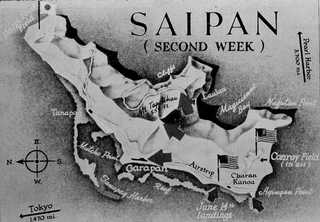Saipan
The following text is from Stepping Stones to Tokyo by Douglas Ide
|
"Saipan - Second Week," from Time 6/44
|
Japanese Lt. Gen. Yoshitsugu Saito, commander of the island's defenders, knew all was lost when Garapan and Tanapag Harbor fell. U.S. Army and Marine troops had pushed what was left of his forces to the northern tip of the island.
Dirty and weary from 23 days of intense fighting, Saito ate canned crab, drank sake, walked to a flat rock and sat down. Then, after telling his army, "I advance to seek out the enemy. Follow me," he plunged his samurai sword into his stomach and had his adjutant shoot him in the back of the head.
His army, and many civilian men, women and children, followed his lead, first making one last charge at the advancing Americans. When that failed, many committed suicide by leaping from the cliffs at Marpi Point.
The 27th Inf. Div. took the brunt of the initial suicide attack. Some 2,000 to 3,000 Japanese troops rushed screaming into the American lines, overwhelming the two regiments. One soldier who survived the onslaught likened it to a Hollywood cattle stampede, saying that the Japanese just kept coming. As bodies mounted, both sides had to clear away some of the dead to continue with their mission. When it was over, more than 4,300 dead Japanese were counted on the beaches at Tanapag.
Saipan became the staging base for the attack on nearby Tinian, three-and-a-half miles south. Tinian was taken with relative ease, falling in one week with some 1,800 American casualties. A prize catch, Tinian boasted three airfields and a fourth under construction. It became an important operational base for the rest of the Pacific war. The B-29 bomber "Enola Gay" would fly from Tinian to drop the first atomic bomb on Japan."
<-- --> | WWII Timeline start | Links | Topics | Pictures | Maps | Documents | Bibliography | revised 12/1/05 by Schoenherr
